

Written by Jennifer Tomlinson
WECAN Network Member | EVP Marketing, QorusDocs
WECAN Network Member, Jennifer Tomlinson, spoke with Gavriella Schuster to discuss the factors impacting the leadership gender divide within the tech industry. As Executive VP of Marketing for QorusDocs, Jennifer works to identify business needs and help QorusDocs’ clients generate revenue more effectively and efficiently. With extensive experience working for and with Enterprise companies, and small/medium businesses, Jennifer is adept at leading successful, scalable strategies across product, audience, and industry-specific marketing. Her specialties include revenue focused marketing, channel marketing, channel partnerships and customer experience.
Featuring Gavriella Schuster
Diversity, Equity and Inclusion Advocate | Global Business Leader | Network Director | Network Advisor | TEDx Speaker | Digital Transformation Leader | Empowering Women in Technology
As a C-Level Microsoft Executive and Thought Leader, Gavriella has helped thousands of businesses of all sizes digitally transform through technology. She has grown a P&L of $10B and led a global portfolio of channel partners that has influenced over $1 trillion in ecosystem revenues through Microsoft’s fastest growing ecosystem. Gavriella is a board member of several leading organizations, including Women in Cloud, Women in Technology Network, International Association of Microsoft Channel Partners, the SHE community, the Women’s Business Collaborative, Corent Technology, chairman of the advisory board for Artificial Solutions, and strategic advisor to Berkshire Partners to focus on bringing more diversity, equity and inclusion into the tech industry.
It’s 2021 and, despite years of struggle, the gender equity gap still exists. In fact, it’s more than a gap; it’s a giant chasm, an abyss, if you will—and it’s a problem. In the C-suite of corporate America, women continue to be underrepresented and paid less than their male counterparts. Research firm Morningstar released a report in February 2021 that highlighted the stark reality of unabating gender disparity in corporate America.
Would it surprise you to learn that:
- men outnumbered women by more than 7:1 in 2019 In the highest ranks of corporate America;
- male CEOs outnumbered female CEOs nearly 17:1;
- more than half of companies studied did not have a single female named executive officer (NEO), including the ecommerce behemoth Amazon (as of 2020); and
- the highest paid senior executive women earned 84.6 cents for every dollar earned by their male counterparts (2019)?
Sadly, for many of us working in the tech sector, these stats aren’t at all surprising. And the disparity isn’t confined to compensation issues or to the top of the ladder. Gender inequality is rife across multiple facets of the corporate world—both at technology companies and within tech roles at companies across the breadth of industry—with women underrepresented and often discriminated against in the workplace.
Employment & Education Gap
While women make up 47% of all employed adults in the U.S., 2015 figures indicate they hold only 25% of computing roles, according to research from the National Center for Women & Information Technology (NCWIT). More recent NCWIT data shows that women represented 23% of computer hardware engineers and 19% of computer software engineers in the workforce in 2019. Tech jobs are the fastest-growing sector of the global economy but, of the 16 million people who hold jobs in tech worldwide, only 4 million are women.
These low tech employment figures aren’t surprising if you look at the number of women earning post-secondary degrees that are positioned to lead to a career in tech; it’s a fraction of the level it needs to be to close the gender gap. While it’s true that more women than ever are earning STEM (science, technology, engineering, and mathematics) degrees, data from the National Science Foundation found that women earning computer science degrees at the bachelor level dropped from 27% in 1997 to only 19% in 2016. The trend is going in the wrong direction.
Many women avoid studying computer science because they fear they won’t fit in. Florenda Lee, a Boston-based computer scientist, encountered this reaction from a close friend who was pondering what major to declare. When asked for recommendations about promising fields, Florenda suggested computer science and was met with a look of disbelief and confusion. “There’s absolutely no way I could major in computer science; I’ve never considered it. I’m sure I can’t program; It’s not for me.” Unfortunately, this aversion to studying in a tech-related field is still a widespread issue that negatively impacts the gender divide.

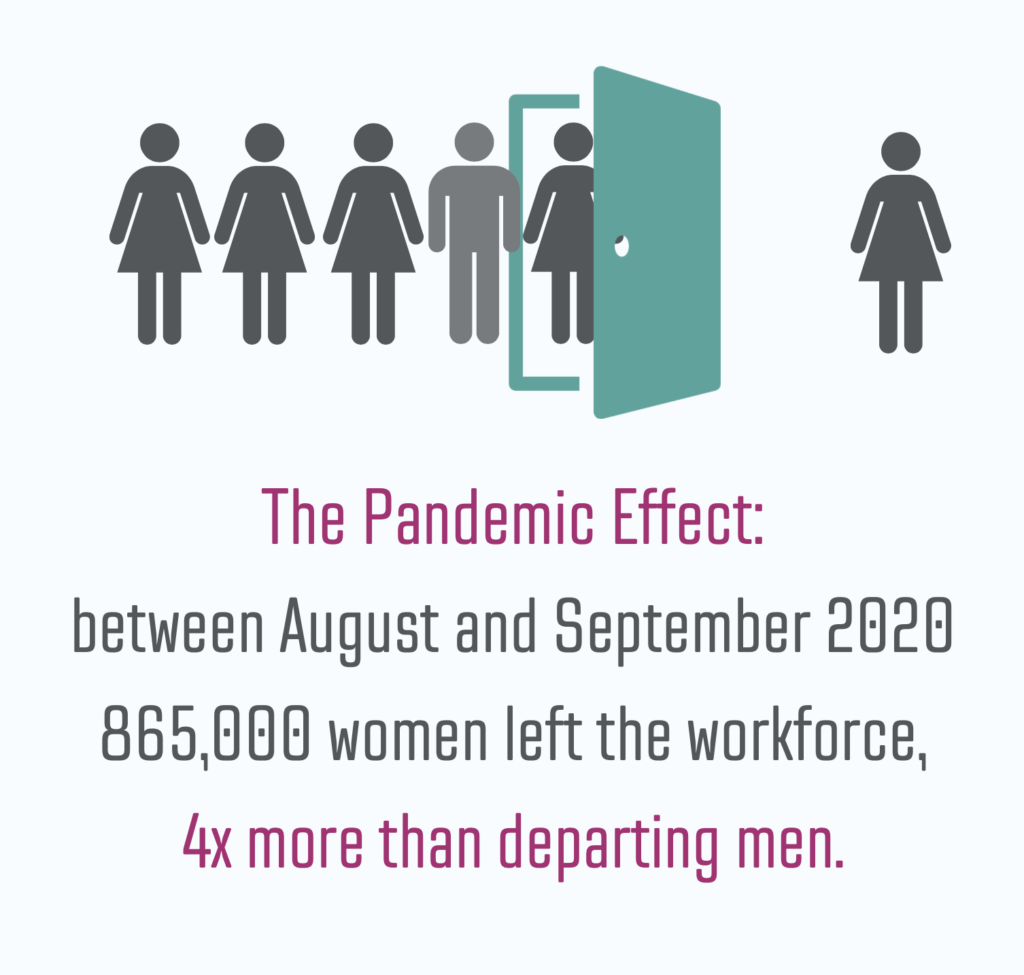
The Pandemic Effect
Before the COVID-19 pandemic turned the economy on its head, the representation of women across all sectors of corporate America was slowly starting to move in a positive direction, most notably in senior management. Between 2015 and 2020, the share of women in SVP roles grew from 23% to 28% and from 17% to 21% percent in the C-suite, according to the McKinsey Women in the Workplace report. Unfortunately, all progress went out the window once the pandemic took hold.
Women—especially women of color—were more likely to have been laid off or furloughed during the Covid-19 crisis, stalling their careers and jeopardizing their financial security. In fact, between August and September 2020, 865,000 women left the workforce, four times more than departing men. And with 25% of women contemplating downshifting their careers or leaving the workforce entirely, gender equity in the workplace is slipping further out of reach.
The Exodus
Unfortunately, the impact of the COVID-19 pandemic is far from the only motivating factor prompting women leaving the workforce. A recent Deloitte article about cultivating diversity, equity, and inclusion in the tech workplace highlighted the story of Aniyah, a divisional technology executive within a large financial banking enterprise. While Aniyah enjoyed her role, over the course of her 12-year career she frequently grappled with the cultural expectation of long work hours, few advancement opportunities, and lack of women role models.
When her spouse received a job offer in another state, Aniyah realized it was time to consider all her options, especially since family planning had become a serious topic in her partnership. Although she wasn’t prepared to write off all future work in technology, she decided to pause her own career to focus on what mattered most at this stage in her life.
Stories like Aniyah’s are happening all across the globe. According to the recent World Economic Forum, at the current dropout rate for women, it will take another 135 years to reach gender equity! This workplace exiting trend, alongside the overall accelerated adoption of technology across all companies, has the potential to exacerbate the gender gap in technology and extend the impact to all industries.
Why Diversity Matters
Why should we all be so concerned about bridging the gender equity divide? Ethics and social justice aside, gender diversity is a smart business decision. Indeed, the business case for diversity in executive teams is strong. A 2021 article in Harvard Business Review highlighted the fact that firms with more women in senior positions are more profitable, more socially responsible, and provide safer, higher-quality customer experiences.
From purely a financial perspective, a 2020 McKinsey report evaluating the value of diversity in the workplace found that companies with more than 30% female executives were more likely to outperform companies with 10% to 30% women executives; in turn, these companies were more likely to outperform those with even fewer women executives, or none at all. “A substantial differential likelihood of outperformance—48%—separates the most from the least gender-diverse companies.”
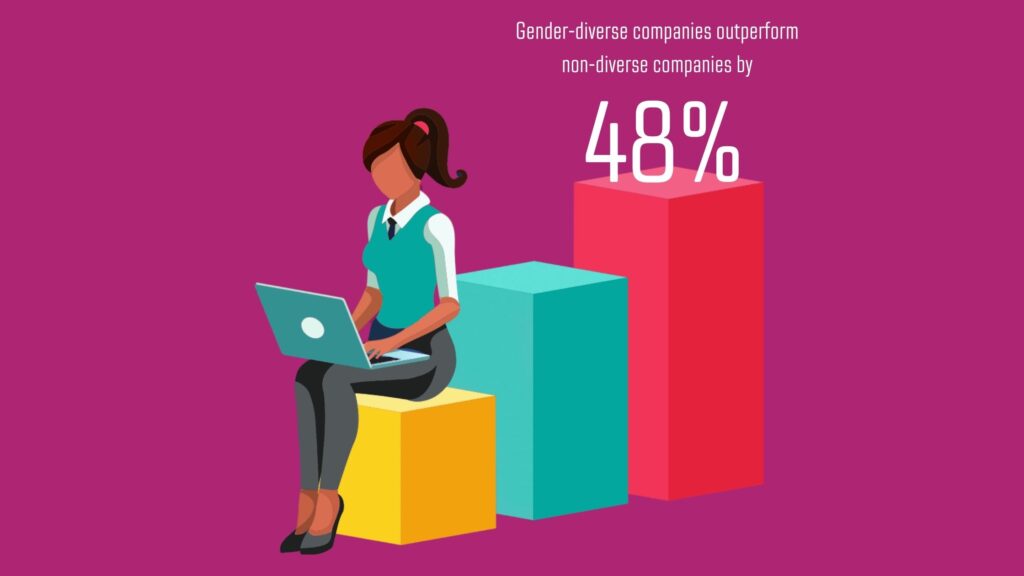
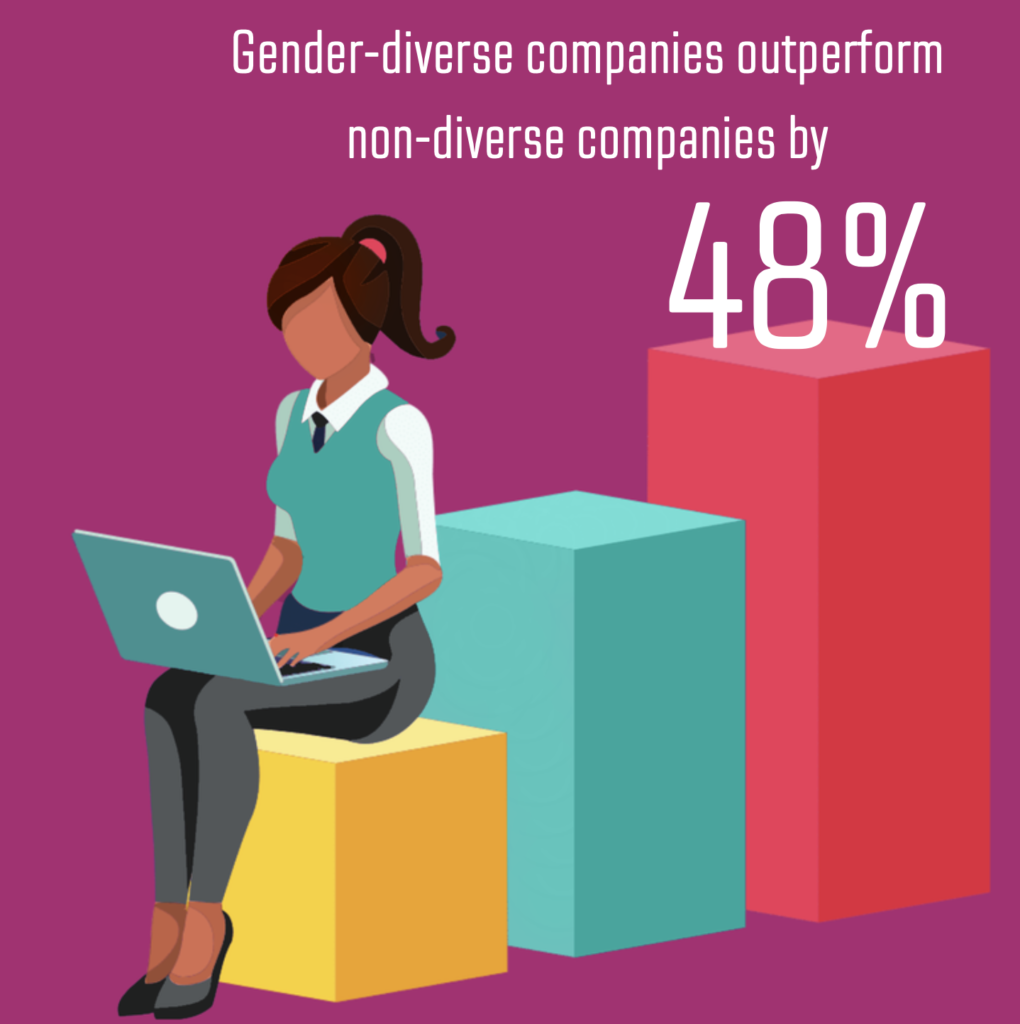
Similarly, a 2018 study by the Boston Consulting Group (BCG) has found that diversity increases the bottom line for companies. The study reported that “increasing the diversity of leadership teams leads to more and better innovation and improved financial performance.” BCG found that companies with more diverse management teams have 19% higher revenues due to innovation, a significant finding for tech companies and start-ups where innovation is integral to growth.
Gavriella Schuster, Corporate Vice President, One Commercial Partner at Microsoft and a leading voice in the drive for gender equity in the tech industry, notes:
“There’s something special that happens when you have gender equity in your team. There’s more collaboration. You get new ideas and fresh perspectives. And as an organization, you become more empathetic. More vulnerable. More human. People aren’t afraid to share what they think. Overall, equitable representation creates a healthier, higher-performing organization.”
Agents of Change
In order to turn the tide, we need to work together to disrupt the status quo. WECAN sat down with Gavriella to discuss why it’s so important to increase the number of women in senior tech roles and how we can use her BeCOME framework (Connect, Outreach, Mentorship, Empowerment) to become agents of change and help narrow the gender equity gap:
Why do we need more women in tech, especially at the senior and C-suite level?
On a strategic level, when women join the C-suite, through the lens of their experiences and the diverse point of view, they shift how the top management team think. Firms become more open to change and more willing to examine their options and possibilities. Indeed, women tend to raise the collective intelligence of a group that’s trying to solve a problem because they are bringing in a different perspective. They tend to be more collaborative and empathetic in their decision making and tend to review all options before pursuing a path, instead of narrowing down to a single approach.
When you have women on the leadership team, they provide a different perspective and bring more balance to a dialogue. And they’re more willing to be vulnerable and admit making mistakes which leads to greater innovation—a driving force for success in the tech and start-up environment. In addition, having a diverse leadership team positively impacts the customer experience because women have more empathy, are more willing to listen to other points of view, and are skilled at building collaboraive environments.
Despite this dire need for more women in tech leadership roles, a recent study by Capgemini Research Institute found that 90% of global businesses struggle with inclusion and diversity practices within their technology and IT teams. Shobha Meera, Chief Corporate Social Responsibility Officer and Group Executive Committee Member at Capgemini, hit the nail on the head when she commented:
“In a world of increasing demand for tech-fueled products and services that are free of discrimination and are inclusive by design, the importance of inclusive tech workforces, cultures and practices, is more important than ever. And yet, we see a wide gap not only in the state of inclusive representation in the tech workforce of organizations, but also in the perceptions of leaders vs. women and ethnic minorities on the state of inclusion in tech.”
The Capgemini report reinforced the idea that organizations need to implement processes, policies, and value systems that champion inclusion. Leaders of tech teams need to ensure that women and ethnic-minority employees are given equal opportunities for career growth, progression, and input into product development, while also building the tech and data foundations for measuring, monitoring, and improving inclusion outcomes. By focusing on diversity and inclusion in their tech teams, organizations will benefit from innovation, revenue, and brand value opportunities.
Can you talk a little about your experience as a woman in a senior role in tech?
I think there is a lack of understanding of what it took for me, or any other woman who built a career within a tech organization, who was the only woman on a team, in a room, on a project to get into the senior ranks. There is still judgement of women that is different than for men in terms of your behavior and how it’s classified. A lot more women are classified as having sharp elbows, as being too aggressive, and yet that same behavior in men is viewed as confidence or simply knowing how to get things done.
Being a woman leader in a male-dominated tech environment presented challenges. I remember when my daughter was about six months old and I worked for an SVP who would only do his strategy sessions from 6:00-8:00 pm, instead of fitting them into a normal business day. Why would I want to give up time with my daughter after my work day is finished to go to a strategy session? But I felt that if I didn’t attend, I’d be robbing my team of all the work they’ve been doing and the visibility of being able to share what they’re doing.
So I brought my 6-month-old baby into this meeting. I took breaks to nurse her and was trying to make a point but it was lost on him. At the end, he said, ‘That was our best strategy session ever. It was great to have your daughter in the room.” What?!
About two months later, his leaders realized just how embarrassing and inappropriate his behavior really was and convinced him that he needed to switch his strategy sessions to fit within normal work hours. I felt like that was a victory but it’s a solid example of why we need more women in leadership; any woman would immediately grasp how inappropriate his actions were.
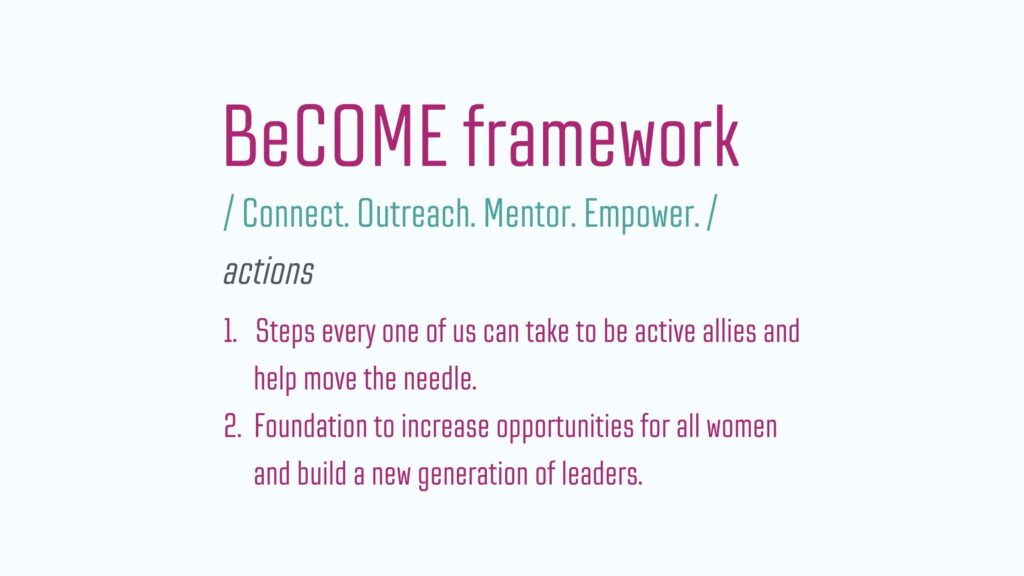
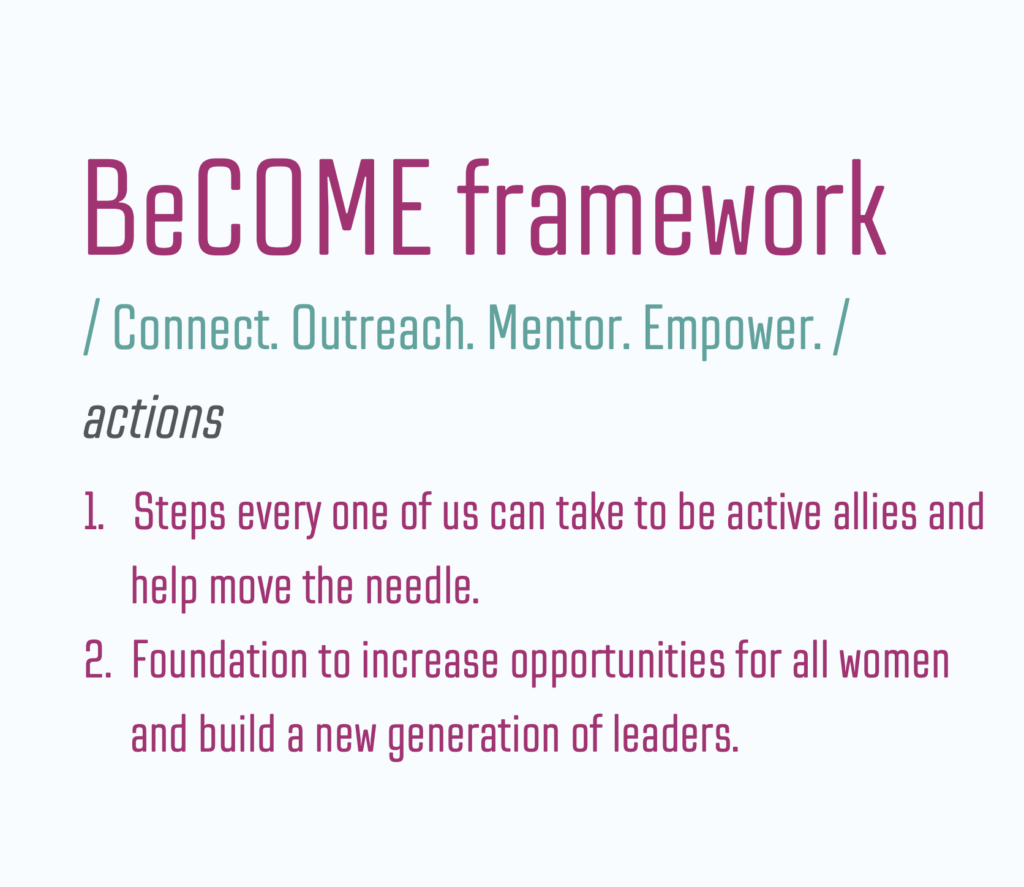
Tell us about the BeCOME framework.
I am encouraging everyone to be an ally, a leader, an agent of change. We need to scale. We need force multipliers. We need more men and women to become agents of change. That’s why I developed the BeCOME framework, which is comprised of four actions every one of us can do to be an active ally and help move the needle: Connect, Outreach, Mentor, and Empower.
Through the BeCOME framework, we can build healthier workplace cultures. We can attract new employees, customers, and investors. We can increase opportunities for all women and build a new generation of leaders that understand the value of equity.
Connect
Reach out and give women access to yourself and to everyone in your professional network. By making intentional connections with women in your network, you can become a force multiplier to turn 20,000 women in technology roles to the 8 million needed to reach gender equity. This purposeful action can make all the difference in the world.
Join an organization dedicated to connecting women in the technology field and creating access to opportunities. Here are a few options:
Women in Cloud is a community-led economic development organization taking action to generate $1B in net new global economic access for women entrepreneurs by 2030 through partnerships with corporations, community leaders, and policy makers.
The WIT Network
We are a global and local Not For Profit organization providing inspiration, education, mentoring, networking and practical advice to empower women (and men) to build and grow their careers in technology and pursue their ambitions. We have three clear missions:
- Encourage women and girls to study STEM and pursue careers in tech
- Enable more women to attain leadership positions and career advancement
- Help companies change the landscape of gender equality within their business
Women in Tech
Women in Tech® is an international non-profit organization on a mission to close the gender gap and to help women embrace technology. We promote girls’ and women’s empowerment around the world, with a focus on Sustainable Development Goal 5b: harnessing technologies.
Women Who Code
Our mission is to inspire women to excel in technology careers
Girls Who Code
Girls Who Code is on a mission to close the gender gap in technology and to change the image of what a programmer looks like and does.
She Runs It (mBolden)
Designed to pave the way for more women to lead at each stage of their careers in marketing, media and tech
The National Center for Women & Information Technology (NCWIT)
Powered by the latest social science research, this community works to increase the meaningful and influential participation of all girls and women in computing—at the intersections of race/ethnicity, class, age, gender identity, sexual orientation, disability status, and other historically marginalized identities—from K-12 through career.
Women’s Business Collaborative
Our mission is to accelerate the advancement of all business women in order to achieve gender, diversity, and pay parity in the workplace.
When deciding which organization to join, consider what kind of women you are looking to network with. If you join Women in Cloud, you’ll be networking with female founders; it’s more about partnerships, new technologies, or venture capital. If you’re going to join Women in Technology (WIT) Network, that’s more about understanding women who are working in the industry and what that experience is like, to help you create a pipeline.
What is your objective for networking and connecting with other women? Is it to learn how to run your own business, get resources, learn marketing? Review the mission statements of the various organizations and make sure it aligns with your objectives.
And just a reminder, these groups are all inclusive organizations; everyone is welcome.
Outreach
Outreach is about examining your recruiting and hiring practices. When you post a job, do you screen out candidates, or do you screen in for diversity? Stop hiring for expediency and intentionally go outside the company and generate truly diverse candidate pools—and then ensure a diverse panel conducts the interviews. You’ll generate a high quality of diverse candidates that can change the culture of your organization for the better.
Supplier selection is also an important element of the Outreach step. Examine the suppliers you work with or the vendors you hire. Do they have diverse representation? Can they do more to create access for women?
Mentor
Mentoring—and being mentored—is a beautiful and fulfilling endeavor. It is a simple action you can take to bring light, energy, and focus to someone’s life. I know first-hand, it’s a key component to bring in and retain more women in the technology industry.
Studies show that good mentoring leads to greater career success for the person getting the advice, while the person giving the advice broadens their network and can strengthen their position as a leader. And mentorship benefits organizations by developing a culture of learning and growth, which increases employee engagement and attracts high-quality talent.
A common misperception is that mentorship is a big long-term ask, that someone has to commit a ton of time, but it doesn’t have to be like that. It can be as simple as that half hour coffee where somebody is just in a moment where they need guidance. Perhaps they want to learn how someone made a move from one company to another or gain insight into starting their own business. Just being able to walk through a decision or idea with a mentor helps put everything in perspective and can make all the difference—and all it took was 30 minutes over coffee.
For me, there have been a lot of these moments where I was looking for perspective on making certain decisions in my career. I looked to several people who had left Microsoft in the last six to eight months and talked to them about their journey. I reached out to a former colleague to talk about boards and private equity vs public vs Series A. He had a ton of perspective and it helped me greatly. Mentorship can be as simple as answering a question and still be immensely valuable.
Empower
Giving someone the ability and the confidence to learn, grow, and do something for themselves is a powerful gift. The most impactful thing you can do for another human being is to empower them and help create an inclusive environment where people can be seen and heard for who they are as individuals.
We need more allies in the workplace to create an environment where people can be their authentic selves. It’s one thing to have people from different backgrounds within the organization, to have the diversity; it’s another thing to really empower them to speak up, to own their point of view, and have the courage to bring that forth because that’s when you get really diversity in the organization.
Women barely represent a quarter of the tech workforce. What actions can men take to help move the needle?
Men need to be allies to women. They need to take intentional action to disrupt the status quo and, through every action, think about bringing more women into their organizations, into their leadership teams, into their BOD, and into their supply chain.
Allies advocate. When there is a woman in the room, they advocate on their behalf. For instance, if I was in a meeting where the engineers are pushing back, my allies would say, “Well, I think Gavriella might be onto something. Let’s hear more.” They bring you into the dialogue and elevate your position.
Allies listen. In many meetings, people ‘listen to respond’ instead of listening to what someone’s saying. It’s important to consider that others may have a different point of view and it could be something worth learning. Allies ‘listen to learn’ vs. ‘listen to respond.’
Allies lift women up. And when a woman is cut down or what she is saying is dismissed, an ally is the one that comes up afterwards and builds her confidence back up. Microaggressions on a daily basis erode your confidence and become a blocker; you start to think you’re not good enough. I think that’s why a lot of women leave tech. They figure it’s not worth feeling bad or think ‘I’m in the wrong place.’
Allies actively try to make sure you are included. When they go into a meeting or a project, they look around to make sure everyone that should be there is present and heard. They elevate your position, meaning they may give you a stretch project, make your work more visible, or give you credit.
They sponsor you into new opportunities, new projects. It took a lot of courage for me to ask for what I needed from my mentor and it took a lot of courage for him to sponsor me into new projects even though I was working part-time. People dismissed me because I was only working part-time: “Well, you have a new baby. You probably don’t have time for this new project.” Give me the opportunity! Let me decide instead of deciding for me.
How do men become allies?
Men can be effective allies to women by embracing the four steps of the BeCOME framework:
Connect – Make intentional connection to women through the way they network. Intentionally expand their networks to include more women.
Outreach – Set governance and process to include more women in every candidate pool, for every role, at every level of the organization. Think top down instead of bottom up; by setting a tone from the top that diverse hiring is important, future candidates can see that there are people who look like them at the top of the organization and be assured that this is an organization where women can be successful.
Mentorship – Ask every member of the organization to mentor women.
Empowerment – Build an inclusive environment by empowering everyone. Include women in the discussions and decisions, value their input, and encourage them to bring their authentic voice.The goal is to work with intentionality: set up systems, processes, and measures to work with intention and measure outcomes.
What are some key steps that would make a difference in the pursuit of gender equity in the workforce?
- If every man in high tech took intentional action to mentor and sponsor at least one woman into high tech (and was successful), we would achieve gender equity.
- Require diverse representation of suppliers in our network and require that they report on their diversity before we do business with them.
- Require that every public organization be transparent and report their gender diversity numbers and pay equity numbers annually.
- Accelerate the adoption of laws, like the ones adopted in California, Germany, France, and Norway, that require female representation on the BOD of every public company, coupled with laws that make it illegal to ask someone what they were paid in their last position.
Today, through technology democratization, purpose-driven leadership, and male allyship, we can close the gap of inequity and create a new narrative. As women entrepreneurs and leaders, we can use our courageous voices to step into powerful leadership roles, inspiring others to become agents of change. Together, we no longer remain invisible.
WECAN: AGENTS OF CHANGE
Women Executives Channel Advisory Network (WECAN) is group of senior leaders in influential technology companies, with a common passion for lifting up and normalizing women in leadership roles in technology companies. With a vision of a technology partner ecosystem where women constitute an equitable share of leadership roles, we offer advisory, mentorship, and educational programs intended to elevate more women into technology leadership roles.
As catalysts for positive growth, we leverage our experiences and sphere of influence to mentor, empower, and elevate women leaders in the technology partner ecosystem, so they can access equitable career and business opportunities and impact channel success. And we help companies provide more mentorship, more opportunities, and ultimately more equity for women in technology.
Connect with us to find out how you can be part of our mission to bridge the gender equity gap.





